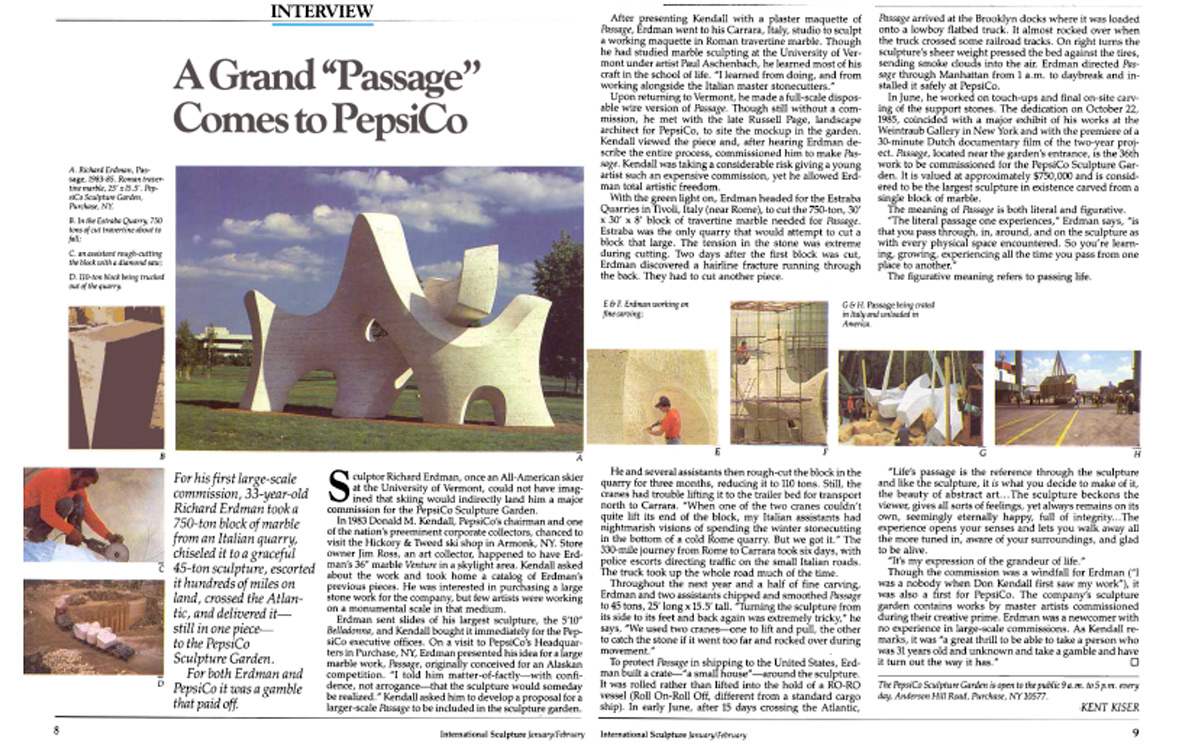
“A Grande “Passage” Comes to PepsiCo”, International Sculpture Magazine
August 28, 2017
International Sculpture Magazine featured Richard Erdman’s monumental sculpture “Passage,’ at the Donald M. Kendall Sculpture Gardens at PepsiCo’s headquarters in Purchase, NY. Read the full text below.
“Sculptor Richard Erdman, once an All.-American skier at the University of Vermont, could not have imagined that skiing would indirectly land him a major commission for the PepsiCo Sculpture Garden.
In 1983 Donald M. Kendall, PepsiCo’s chairman and one of the nation’s preeminent corporate collectors, chanced to visit the Hickory & Tweed ski shop in Armonk, NY. Store owner Jim Ross, an art collector, happened to have Erdman’s 36″ marble Venture in a skylight area. Kendall asked about the work and took home a catalog of Erdman’s previous pieces. He was interested in purchasing a large stone work for the company, but few artists were working on a monumental scale in that medium.
Erdman sent slides of his largest sculpture, the 5’10” Belladonna, and Kendall bought it immediately for the PepsiCo executive offices. On a visit to PepsiCo’s Headquarters in Purchase, NY, Erdman presented his idea for a large marble work, Passage, originally conceived for an Alaskan competition.”I told him matter-of-factly-with confidence, not arrogance-that the sculpture would someday be realized.” Kendall asked him to develop a proposal for a larger-scale Passage to be included in the sculpture garden.
After presenting Kendall with a plaster maquette of Passage, Erdman went to his Carrara, Italy, studio to sculpt a working maquette in Roman travertine marble. Though he had studied marble sculpting at the University of Vermont under artist Paul Aschenbach, he learned most of his craft in the school of life. “I learned from doing, and from working alongside the Italian master stonecutters.”
Upon returning to Vermont, he made a full-scale disposable wire version of Passage. Though still without a commission, he met with the late Russell Page, landscape architect for PepsiCo, to site the mockup in the garden. Kendall viewed the piece and, after hearing Erdman describe the entire process, commissioned him to make Passage. Kendall was taking a considerable risk giving a young artist such an expensive commission, yet he allowed Erdman total artistic freedom.
With the green light on, Erdman headed for the Estraba Quarries in Tivoli, Italy (near Rome), to cut the 750-ton, 30′ x 30′ x 8′ block of travertine marble needed for Passage. Estraba was the only quarry that would attempt to cut a block that large. The tension in the stone was extreme during cutting. Two days after the first block was cut, Erdman discovered a hairline fracture running through the back. They had to cut another piece.
He and several assistants then rough-cut the block in the quarry for three months, reducing it to 110 tons. Still, the cranes had trouble lifting it to the trailer bed for transport north to Carrara. “When one of the two cranes couldn’t quite lift its end of the block, my Italian assistants had nightmarish visions of spending the winter stonecutting in the bottom of a cold Rome quarry. But we got it.” The 330-mile journey from Rome to Carrara took six days, with police escorts directing traffic on the small Italian roads. The truck took up the whole road much of the time.
Throughout the next year and a half of fine carving, Erdman and two assistants chipped and smoothed Passage to 45 tons, 25′ long x 15.5′ tall. “Turning the sculpture from its side to its feet and back again was extremely tricky,” he says.. “We used two cranes—one to lift and pull, the other to catch the stone if it went too far and rocked over during movement.”
To protect Passage in shipping to the United States, Erdman built a crate-“a small house”-around the sculpture. It was rolled rather than lifted into the hold of a RO-RO vessel (Roll On-Roll Off, different from a standard cargo ship). In early June, after 15 days crossing the Atlantic,
Passage arrived at the Brooklyn docks where it was loaded onto a lowboy flatbed truck. It almost rocked over when the truck crossed some railroad tracks. On right turns the sculpture’s sheer weight pressed the bed against the tires, sending smoke clouds into the air. Erdman directed Passage through Manhattan from 1a.m. to daybreak and installed it safely at PepsiCo.
In June, he worked on touch-ups and final on-site carving of the support stones. The dedication on October 22, 1985, coincided with a major exhibit of his works at the Weintraub Gallery in New York and with the premiere of a 30-minute Dutch documentary film of the two-year project. Passage, located near the garden’s entrance, is the 36th work to be commissioned for the PepsiCo Sculpture Garden. It is valued at approximately $750,000 and is considered to be the largest sculpture in existence carved from a single block of marble.
The meaning of Passage is both literal and figurative. “The literal passage one experiences,” Erdman says, “is that you pass through, in, around, and on the sculpture as with every physical space encountered. So you’re learning, growing, experiencing all the time you pass from one place to another.” The figurative meaning refers to passing life.
“Life’s passage is the reference through the sculpture and like the sculpture, it is what you decide to make of it, the beauty of abstract art…The sculpture beckons the viewer, gives all sorts of feelings, yet always remains on its own, seemingly eternally happy, full of integrity…The experience’ opens your senses and lets you walk away all the more tuned in, aware of your surroundings, and glad to be alive.
“It’s my expression of the grandeur of life.”
Though the commission was a windfall for Erdman (“I was a nobody when Don Kendall first saw my work”), it was also a first for PepsiCo. The company’s sculpture garden contains works by master artists commissioned during their creative prime. Erdman was a newcomer with no experience in large-scale commissions. As Kendall remarks, it was ”a great thrill to be able to take a person who was 31 years old and unknown and take a gamble and have it tum out the way it has.”
International Sculpture Magazine



